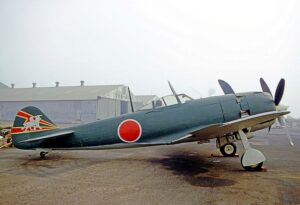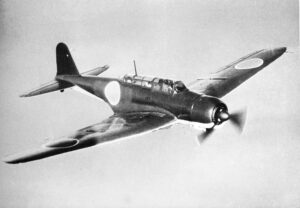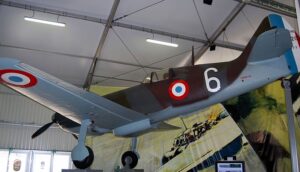Time Period: World War II
Country of Origin: Japan
Type: Fighter Aircraft
Manufacturer: Nakajima Aircraft Company
Nakajima Ki-43 Hayabusa Aircraft Overview
The Nakajima Ki-43 Hayabusa, commonly known by its Allied codename “Oscar,” was a lightweight fighter aircraft used by the Imperial Japanese Army Air Service during World War II. Developed by Nakajima Aircraft Company, the Ki-43 Hayabusa was designed to meet the Japanese Army’s requirements for an agile and maneuverable fighter aircraft.
The Ki-43 first flew in January 1939 and entered service with the Imperial Japanese Army Air Service later that year. It quickly gained a reputation for its exceptional maneuverability, high rate of climb, and good handling characteristics. The aircraft featured a streamlined, all-metal monoplane design with a low wing configuration and an inline engine.
Powered by a Nakajima Ha-25 radial engine, the Ki-43 Hayabusa had a top speed of around 310 mph (500 km/h) and was armed with two 7.7mm machine guns mounted in the fuselage. Later variants, such as the Ki-43-II and Ki-43-III, were equipped with improved armament, including heavier machine guns and cannons.
The Ki-43 Hayabusa saw extensive service throughout the Pacific theater of World War II, where it was used for air defense, ground attack, and reconnaissance missions. It participated in numerous aerial engagements against Allied aircraft, including the American P-40 Warhawk and P-38 Lightning, as well as the British Commonwealth’s fighters.
Despite its agility and maneuverability, the Ki-43 Hayabusa had certain weaknesses, including light armor protection for the pilot and fuel tanks, which made it vulnerable to enemy fire. Additionally, its armament was considered inadequate compared to contemporary Allied fighters.
Nevertheless, the Ki-43 Hayabusa remained in service throughout the war and was flown by Japanese Army Air Force pilots in various theaters of operation, including Burma, New Guinea, and the Philippines. It earned a reputation as a highly capable and respected fighter aircraft, although its effectiveness declined in the face of increasingly advanced Allied fighters and tactics as the war progressed.
Nakajima Ki-43-IIb Specifications
- Crew: One
- Length: 8.92 m (29 ft 3 in)
- Wingspan: 10.84 m (35 ft 7 in)
- Height: 3.27 m (10 ft 9 in)
- Wing area: 21.4 m2 (230 sq ft)
- Airfoil: root: NN-12 mod. (18%); tip: NN-12 mod. (8%)
- Empty weight: 1,910 kg (4,211 lb)
- Gross weight: 2,590 kg (5,710 lb)
- Max takeoff weight: 2,925 kg (6,449 lb)
- Fuel capacity: 550 L (120 imp gal) plus 2 × 200 L (53 US gal; 44 imp gal) drop tanks
- Powerplant: 1 × Nakajima Ha-115 14-cylinder air-cooled radial piston engine, 970 kW (1,300 hp) for take-off. 890 kW (1,200 hp) at 3,000 m (9,800 ft). 820 kW (1,100 hp) at 6,200 m (20,300 ft)
- Propellers: 3-bladed metal constant-speed propeller, 2.79 m (9 ft 2 in) diameter.
Nakajima Ki-43-IIb Performance
- Maximum speed: 530 km/h (330 mph, 290 kn) at 4,000 m (13,000 ft)
- Cruise speed: 440 km/h (270 mph, 240 kn)
- Range: 1,760 km (1,090 mi, 950 nmi)
- Ferry range: 3,200 km (2,000 mi, 1,700 nmi)
- Service ceiling: 11,200 m (36,700 ft)
- Time to altitude: 5,000 m (16,000 ft) in 5 minutes, 49 seconds
- Wing loading: 121 kg/m2 (25 lb/sq ft)
- Power/mass: 0.33 kW/kg (0.20 hp/lb)
Nakajima Ki-43-IIb Armament
- Guns: 2 × 12.7 mm (0.500 in) Ho-103’s in the forward fuselage with 270 rpg
- Bombs: 2 × 30 kg (66 lb) bombs or 2 × 250 kg (550 lb) bombs.
Nakajima Ki-43 Hayabusa Image Gallery
More Nakajima Aircraft

Nakajima A6M2-N
The Nakajima A6M2-N was a single-crew floatplane aircraft created in 1941 and based on the Mitsubishi A6M Zero Model 11.

Nakajima J1N “Gekko”
The Nakajima J1N “Gekko” is a twin-engine aircraft used by the Japanese Imperial Navy during World War II.

Nakajima Ki-84 “Hayate”
The Nakajima Ki-84 was a Japanese single-seat fighter aircraft used by the Imperial Japanese Army Air Service during World War II.

Nakajima B5N
The Nakajima B5N was a Japanese carrier-based torpedo bomber used during the Second World War by the Imperial Japanese Navy (IJN).










